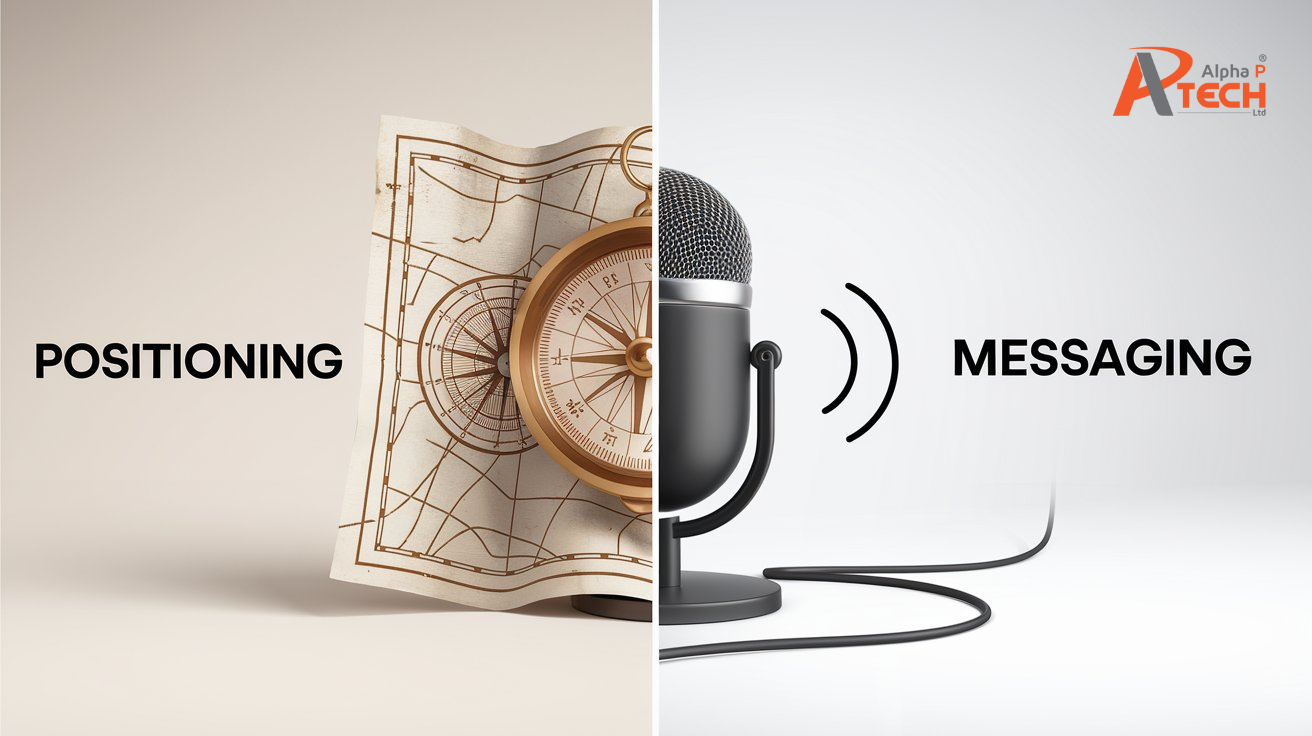Words Alone Won’t Save You
You’ve refined your homepage copy. Your team’s publishing regular LinkedIn posts. You’ve even hired a top-tier B2B copywriter. But still — the leads aren’t coming in, or worse, they’re the wrong ones.
Sound familiar? This is a common frustration for professional service firms, especially those investing in modern B2B marketing strategies yet struggling to convert interest into action. The issue isn’t always the message — it’s the foundation behind it. Too often, firms confuse positioning with messaging, asking copywriters to create clarity where there is none.
But here’s the truth: no amount of clever phrasing or compelling content can fix a lack of strategic direction. Without clear positioning, your messaging — no matter how well written — won’t resonate, differentiate, or convert. If your words aren’t working, it might be time to look beyond the copy and revisit the strategy. That’s where true thought leadership begins.
What Positioning Really Means in a B2B Copywriting Context
Positioning is more than a marketing buzzword — it’s the strategic bedrock that determines how your firm is perceived by the people who matter most. In a B2B copywriting context, positioning defines the unique space your business occupies in the minds of your ideal clients. It shapes the tone of voice your brand uses, the clarity of your value propositions, and the confidence behind your calls to action.
Without a well-defined position, even the most polished messaging will lack direction and fall flat. Consider the difference between “We’re a growth consultancy for scaling SaaS firms” and “We help businesses grow.” One establishes authority and filters for the right audience; the other is so broad it could apply to anyone — and therefore resonates with no one.
Effective B2B marketing strategies begin with clear positioning. It’s what enables firms to cut through the noise, express real expertise, and establish thought leadership that feels both specific and valuable.
Copywriters don’t invent your brand; they translate it.
What Messaging Is — And Why Copywriters Can’t Invent It from Thin Air
Whilst positioning defines your brand’s unique value, messaging is how you express it — it’s how your brand communicates its value across every touchpoint. From a B2B copywriting perspective, messaging includes everything from homepage headlines and email subject lines to taglines, social media bios and ad copy. It’s the language that makes your positioning tangible and relatable.
But here’s where many professional service firms slip up: they task a copywriter with “creating messaging” before the strategic groundwork has been done. Without clear positioning, messaging becomes guesswork — and the result is often style over substance.
Strong B2B marketing strategies begin with clarity at the core. Once your position is defined, messaging can flex by audience, platform, or campaign while still remaining consistent. It’s that consistency — across formats and contexts — that builds familiarity, credibility, and, ultimately, thought leadership. Copywriters don’t invent your brand; they translate it. And the quality of that translation depends entirely on how well your positioning has been defined.
How the Confusion Shows Up in Real Life — And Why It’s Costly
When positioning and messaging are muddled, the impact is seen everywhere in your B2B copywriting. You’ll see it in homepage headlines that sound professional but say nothing unique. You’ll hear it in vague value propositions that try to speak to everyone but convince no one. And more often than not, the firm’s real positioning — if it exists at all — is buried in an “About Us” page, rather than guiding every word across the site. The ripple effect? Confused visitors, wasted traffic, poor-quality leads, and a steady erosion of trust.
Take AGS Group, a B2B company struggling to communicate the value of its complex services across multiple sub-brands. Despite previous efforts to improve messaging, the core issue remained: unclear brand positioning.
It wasn’t until they clarified their strategic direction and developed consistent, audience-focused messaging that things shifted. With that clarity, their website copy began to resonate, their value proposition stood out, and their communications started positioning them as true leaders in their space. Not only did it reinforce their market position, but it allowed them to effectively communicate across their diversified sub-brands.
Strong messaging is powered by strong positioning. Without it, even the best B2B marketing strategies will fall flat — and no amount of copy polish will change that.
How Clear Positioning Supercharges Your B2B Copywriting
When your positioning is crystal clear, B2B copywriting transforms from surface-level polish into a strategic growth tool. Suddenly, your words gain purpose.
- Headlines speak directly to your ideal client’s pain points, not vague aspirations.
- Case studies stop being generic success stories and instead showcase your expertise in solving a specific, high-stakes problem.
- Calls to action shift from passive “get in touch” messages to well-timed nudges that align with the buyer’s mindset and stage of awareness.
This level of clarity doesn’t happen by accident. It stems from knowing exactly who you are, who you serve, and why that matters. For copywriters, this becomes the “why” behind every word — the strategic compass that ensures the tone, structure, and substance of your content all point in the same direction. The result? Higher engagement, faster conversions, and stronger differentiation in saturated markets.
In a landscape where attention is scarce, and trust is hard-won, strong positioning does more than sharpen your messaging — it builds authority. It signals confidence. It lays the groundwork for genuine thought leadership that attracts the right kind of clients. Or, as we like to say: positioning is what gives your words gravity. Without it, even the most eloquent copy can feel weightless.
How to Align B2B Positioning and Messaging Before Writing Copy
Before a single word of copy is written, your positioning needs to be rock solid. From a B2B copywriting perspective, clarity upfront means fewer rewrites, sharper messaging, and stronger performance across every channel.
- Start by defining your niche and area of expertise — not just the services you offer, but the specific outcomes you deliver.
- Then, aim to carve out a clear category of one. For example: “We’re the only firm that delivers regulatory risk audits exclusively for fintech scaleups.” That level of specificity doesn’t just attract the right clients — it repels the wrong ones.
- Next, build a message house: your core positioning statement, supported by key pillars and tailored messaging for different buyer personas or industries. This ensures consistency without sounding repetitive.
- Finally, audit your existing content — homepage copy, service pages, even LinkedIn posts — and ask: does this express our real position, or just sound professional?
Strong positioning is the strategic foundation that fuels effective B2B marketing strategies and establishes genuine thought leadership. Before hiring a copywriter, make sure you’ve nailed your positioning or find a copywriter who can also advise on stray. Otherwise, you’re just dressing up confusion.
Closing Thoughts: Strategy Before Syntax
Great B2B copywriting isn’t just about crafting elegant phrases or clever headlines — it’s about building from a foundation of clarity. If your messaging feels inconsistent or your content isn’t converting, it’s likely not a writing issue, but a strategic one. Without strong positioning, even the most polished copy will struggle to land. But when your positioning is clear and confident, the messaging flows naturally — because it’s rooted in truth, relevance, and focus.
This is the secret behind the most effective B2B marketing strategies and the kind of thought leadership that drives real commercial results. At Alpha P Tech, we blend copywriting expertise with strategic marketing insight to help professional service firms define their position, sharpen their message, and win better clients. If your brand sounds good but still struggles to convert, we can help you find — and say — what truly sets you apart. Our approach combines clarity with persuasion — so the right clients come to you. Let’s talk.



